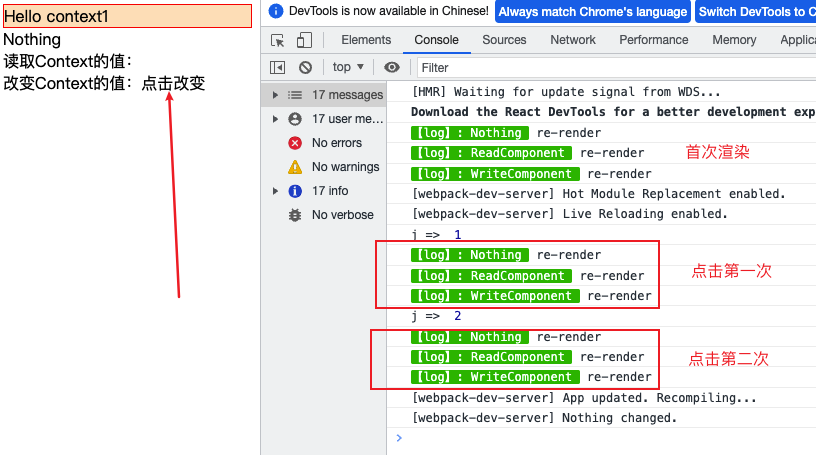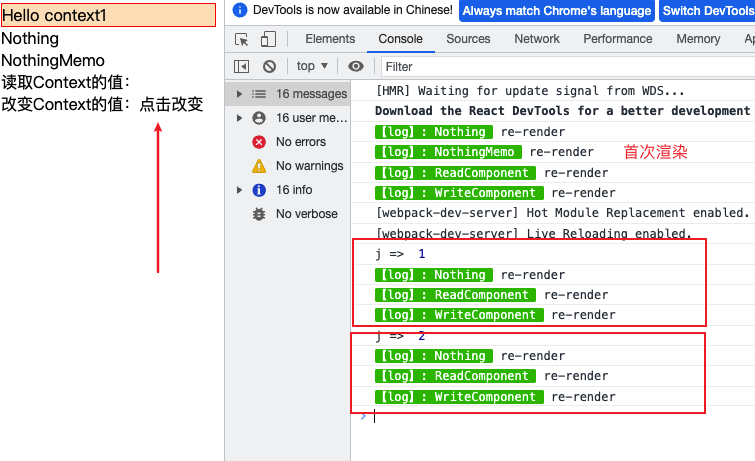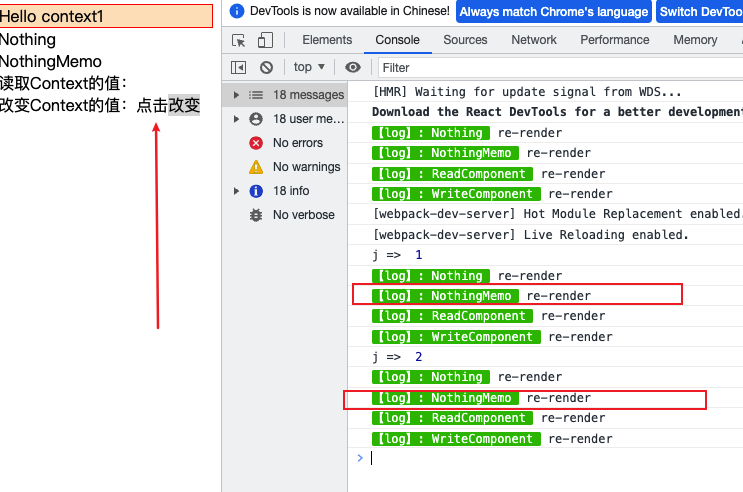useContext 重渲染问题
注:本文不会介绍 useContext 和 useReducer 怎么使用,如读者对这两个的使用还有疑惑,可以移步React 官网,以下更多的是从实践中得到的经验
基本概念
官方中文文档:
https://zh-hans.reactjs.org/docs/context.html
https://zh-hans.reactjs.org/docs/hooks-reference.html#usecontext
context 的出现就是为了处理多层级组件之间更容易通信的问题,避免数据通过 props 属性一直在组件间自上而下(由父及子)进行传递出现的繁琐场景, 如果你遇到以下场景,那么就适合使用 useContext 结合 useReducer 来处理:
页面展示依赖状态数据实时改变
举例:
假如你有一组数据,在用户访问当前页面的期间有可能被实时改变,而页面有较多地方,都要去获取它实时改变状态,那么我们不可能每一层组件以 props 的方式一个一个自上而下的去传递,这个时候就适合使用 context
组件层级较深
举例:
有一个 token 参数,需要在页面中,每一处跳转的时候,携带,而跳转的地方分布在各个组件
项目初期
我之前使用过 Vue,所以对于页面共享数据,习惯的思维就是,这个数据是整一个页面共享的,也就是全局数据,于是我们写这样的例子
context.ts
import { createContext, useContext } from "react";
// 全局数据
class globalStore {
i = 0;
token = "";
loading = true;
canvasConfig = [];
showQuestionLayer = false;
showRule = false;
posterPopup = {
show: false,
imgUrl: "",
};
userInfoData = {
isShowLayer: false,
};
isError = false;
}
const globalContext = createContext(null);
const useGlobalContext = () => useContext(globalContext);
export { globalContext, globalStore, useGlobalContext };
reducer.ts
组件中一旦 dispatch,就会引起 state 更新(引用地址变化),进而触发 globalContext.Provider组件上 value 的更新,组件树重新渲染
/**
* 全局的 Reducer
*/
function pageReducer(state: any, action: { type: any, payload: any }) {
switch (action.type) {
case "__setStore":
state = Object.assign(state, action.payload);
break;
default:
console.error("reducer error", action);
return state;
}
return { ...state };
}
export default pageReducer;
index.ts
这里我们就利用useContext和useReducer初步实现了一个不同层级组件间,共用一份数据的方案
其中ReadComponent为获取全局数据的组件,WriteComponent为做 dispatch 操作的组件,而Nothing组件什么都不做,是普通组件
import React, { useReducer } from "react";
import ReactDOM from "react-dom/client";
import { Nothing, ReadComponent, WriteComponent } from "./components/index";
import { globalStore, globalContext } from "./context";
import pageReducer from "./reducer";
import "./index.scss";
function Index(): React.ReactElement {
const [state, dispatch] = useReducer(pageReducer, new globalStore());
return (
<globalContext.Provider value={{ state, dispatch }}>
<div className="page">Hello context1</div>
<Nothing />
<ReadComponent />
<WriteComponent />
</globalContext.Provider>
);
}
const root = ReactDOM.createRoot(document.getElementById("root"));
root.render(<Index />);
注意到以下三个组件都有日志打印
// ReadComponent
import { useGlobalContext } from '../../context';
import { log } from '@common/utils';
import React from 'react';
export default function ReadComponent() {
log.info('ReadComponent', 're-render');
const state = useGlobalContext();
return <div>读取Context的值:{state && state.i}</div>;
}
// WriteComponent
import React from 'react';
import { useGlobalContext } from '../../context';
import { log } from '@common/utils';
let j = 0;
export default function WriteComponent() {
log.info('WriteComponent', 're-render');
const { dispatch } = useGlobalContext();
const changeContext = () => {
dispatch({
type: '__setStore',
payload: {
i: ++j,
},
});
console.log('j => ', j);
};
return (
<div>
改变Context的值:
<a className="App-link" onClick={changeContext}>
点击改变
</a>
</div>
);
}
// Nothing
import React from 'react';
import { log } from '@common/utils';
export default function Nothing() {
log.info('Nothing', 're-render');
return <div>Nothing</div>;
}
一切似乎都可以正常工作,开发组件也没有问题,所以我们不断的往globalContext.Provider里面加组件,这个时候你肯定会想,为啥要往globalContext.Provider加组件?不是一般用到全局数据的组件才往里面加吗?不然每一次 value 的值更新,就会导致里面所有的组件重新渲染,如下图所示

我们点击改变,组件Nothing并没有去读取globalContext.Provider提供的 value,也同样重新渲染了,这意味着,只要 value 变化,Provider 里面的子组件都会重新渲染
官网提到:
当组件上层最近的
<MyContext.Provider>更新时,该 Hook 会触发重渲染,并使用最新传递给MyContextprovider 的 contextvalue值。即使祖先使用React.memo或shouldComponentUpdate,也会在组件本身使用useContext时重新渲染。
确实是这样,但是有没有思考一个问题,我的页面布局依赖组件的编排,要是把无需全局 state 数据的组件移到 Provider 外面,就会影响页面编排,即以下图片所示问题,这个时候我还要考虑,怎么去拆分不会更改和读取到全局state数据的组件?

使用React.memo来优化
无副作用
明白 memo 的作用后,我们使用 memo 来优化组件渲染问题,我们新增一个NothingMemo组件,如下:
import React from "react";
import { log } from "@common/utils";
function NothingMemo() {
log.info("NothingMemo", "re-render");
return <div>NothingMemo</div>;
}
export default React.memo(NothingMemo);
点击改变,看控制台

我们可以看到,在点击改变按钮时,NothingMemo组件就不会重新渲染了
写入操作
那假如我们NothingMemo组件会 dispatch 去改变全局数据呢?如下:
import React from 'react';
import { log } from '@common/utils';
+ import { useGlobalContext } from '../../context';
function NothingMemo() {
log.info('NothingMemo', 're-render');
+ const { dispatch } = useGlobalContext();
return <div>NothingMemo</div>;
}
export default React.memo(NothingMemo);
依然会重新渲染,因为 dispatch 函数是塞在 Provider 上的 value 中,value 引用地址改变,当然会重新渲染组件,这是肯定的

比较回调
那么我们这时候想着,如果我们给 memo 加上一个比较函数,也就是 memo 的第二次参数
import React from 'react';
import { log } from '@common/utils';
import { useGlobalContext } from '../../context';
function NothingMemo(props) {
log.info('NothingMemo', 're-render');
+ const { skuId } = props;
const { dispatch } = useGlobalContext();
+ return <div>NothingMemo skuId: {skuId}</div>;
}
+ export default React.memo(NothingMemo, (preProps, nextProps) => {
+ if (preProps.skuId != nextProps.skuId) {
+ return false;
+ }
+ return true;
});
// 首页代码(截取一部分)
function Index(): React.ReactElement {
const [state, dispatch] = useReducer(pageReducer, new globalStore());
return (
<globalContext.Provider value={{ state, dispatch }}>
<div className="page">Hello context1</div>
<Nothing />
+ <NothingMemo skuId="12345678" />
<ReadComponent />
<WriteComponent />
</globalContext.Provider>
);
}
const root = ReactDOM.createRoot(document.getElementById('root'));
root.render(<Index />);
我们增加了 memo 的比较函数,函数中代码的意思也就是当 props 中的 skuId 变化了,我们才重新渲染组件,我们来看实际效果,如下:

注意,我们并没有去改变 skuId,但是实际效果,依然重新渲染了,所以这种优化不严谨
使用 useMemo 来优化
这里在 Provider 新增了NothingUseMemo子组件,同样以上面的方式验证,这里贴出代码,具体就不验证了,这里没什么特殊的,也就是和 useMemo 的用法一样,useMemo 内部会根据依赖项的变化而变化,而 useMemo 外部则不可避免的会重新渲染
function NothingUseMemo(props: { skuId: any }) {
log.info('NothingUseMemo', 're-render');
+ const { skuId } = props;
+ return React.useMemo(() => {
+ log.info('NothingUseMemo', 'useMemo re-render');
return <div>NothingUseMemo {skuId}</div>;
+ }, [skuId]);
}
export default NothingUseMemo;
总结
React.memo
官方文档:https://zh-hans.reactjs.org/docs/react-api.html#reactmemo
- Memo 仅检查 props 变更
- 默认情况下其只会对复杂对象做浅层对比
- 仅作为**性能优化**的方式而存在。但请不要依赖它来“阻止”渲染
参考文章
如何优雅地处理使用 React Context 导致的不必要渲染问题?【必看】
 首页
首页